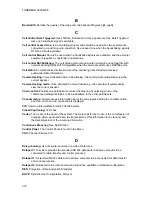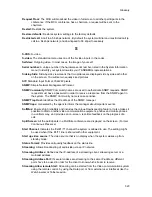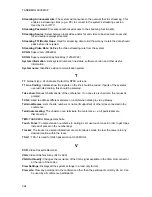
Glossary
323
Request Floor:
The MCU will broadcast the video in full screen to all other participants in the
conference. If the MCU conference has a chairman, a request will be sent to the
chairman.
Restart:
Restarts the system.
Restore defaults:
Restores system settings to the factory defaults.
Restricted call:
A call to a 56 kbps network. By default the system will dial an unrestricted call (a
call to a 64 kbps network) and downspeed to 56 kbps if necessary.
S
S-VHS:
S-video
S-video:
The standard camera uses one of the S-video inputs in the codec.
Selfview:
Outgoing video. In most cases, the image of your self.
Serial number:
A unique number (the hardware serial number, listed in the System Information
menu) to identify your system towards your TANDBERG representatives.
Side-by-Side:
Side-by-side view means that two pictures are displayed side by side each other
on the screen. You will se two equally sized pictures.
SIF:
Standard Input Format, 352x240 pixels
SNMP:
Simple Network Management Protocol.
SNMP Community:
SNMP Community names are used to authenticate SNMP requests. SNMP
requests must have a password in order to receive a response from the SNMP agent in
the system. The SNMP Community name is case sensitive.
SNMP Trap Host:
Identifies the IP-address of the SNMP manager.
SNMP traps:
Generated by the agent to inform the manager about important events.
SoftMux:
Ensures high reliability and includes the unique Downspeeding feature. It also makes it
possible to dial to another video communication equipment, phones and mobile phones
in a uniform way, and provides an on-screen, real-time feedback on the progress of a
call.
Split Screen:
All the participants in a MultiSite conference are displayed on the screen. (Former
Continuous Presence)
Start Channel:
Indicates the firstE1/T1 channel the system is allowed to use. The setting might
be used when if the E1/T1 line is shared with other equipment.
Start up video source:
The video source that is on display when the system wakes up from
standby mode.
Status Format:
Provides call quality feedback on the status line.
Streaming:
Allows broadcasting of audio/video via an IP network.
Streaming Address:
Defined as the IP-address of a streaming client, streaming server or a
multicast address.
Streaming Address Port:
If several codecs are streaming to the same IP-address, different
ports have to be used in order for the client to know which stream to receive.
Streaming Allow remote Start:
Streaming can be started from the Video communication system
using the remote control, by using the Data port, or from external user interfaces like the
Web-browser or Telnet session.
Содержание 6000 MXP Profile
Страница 14: ......
Страница 30: ...TANDBERG 6000 MXP 16 2 3 Monitor Configuration The monitor is pre configured and only needs to be switched on ...
Страница 145: ...General Use 131 PC Presentation shown in Wide stretched mode ...
Страница 205: ...General Use 191 Voice Switched mode ...
Страница 207: ...General Use 193 5 7 Security Security contains the settings Encryption Encryption Mode Passwords Camera Standby mode ...
Страница 255: ...Peripheral Equipment 241 All signals are electrically according to RS232 Cable length max 5 meter X21 ...
Страница 268: ...TANDBERG 6000 MXP 254 ...
Страница 293: ...Appendices 279 ...
Страница 297: ...Appendices 283 Top view ...
Страница 300: ...TANDBERG 6000 MXP 286 Dimensions Front view Side view Rear view Underside view ...
Страница 314: ...TANDBERG 6000 MXP 300 Appendix 17 Dimensions Dimensions with the Precision HD Camera ...
Страница 315: ...Appendices 301 ...
Страница 316: ...TANDBERG 6000 MXP 302 Dimensions with the WAVE II Camera Front view 50 monitor Top view with base ...
Страница 317: ...Appendices 303 Top view 50 monitor ...
Страница 318: ...TANDBERG 6000 MXP 304 Codec ...
Страница 320: ...TANDBERG 6000 MXP 306 ...





































